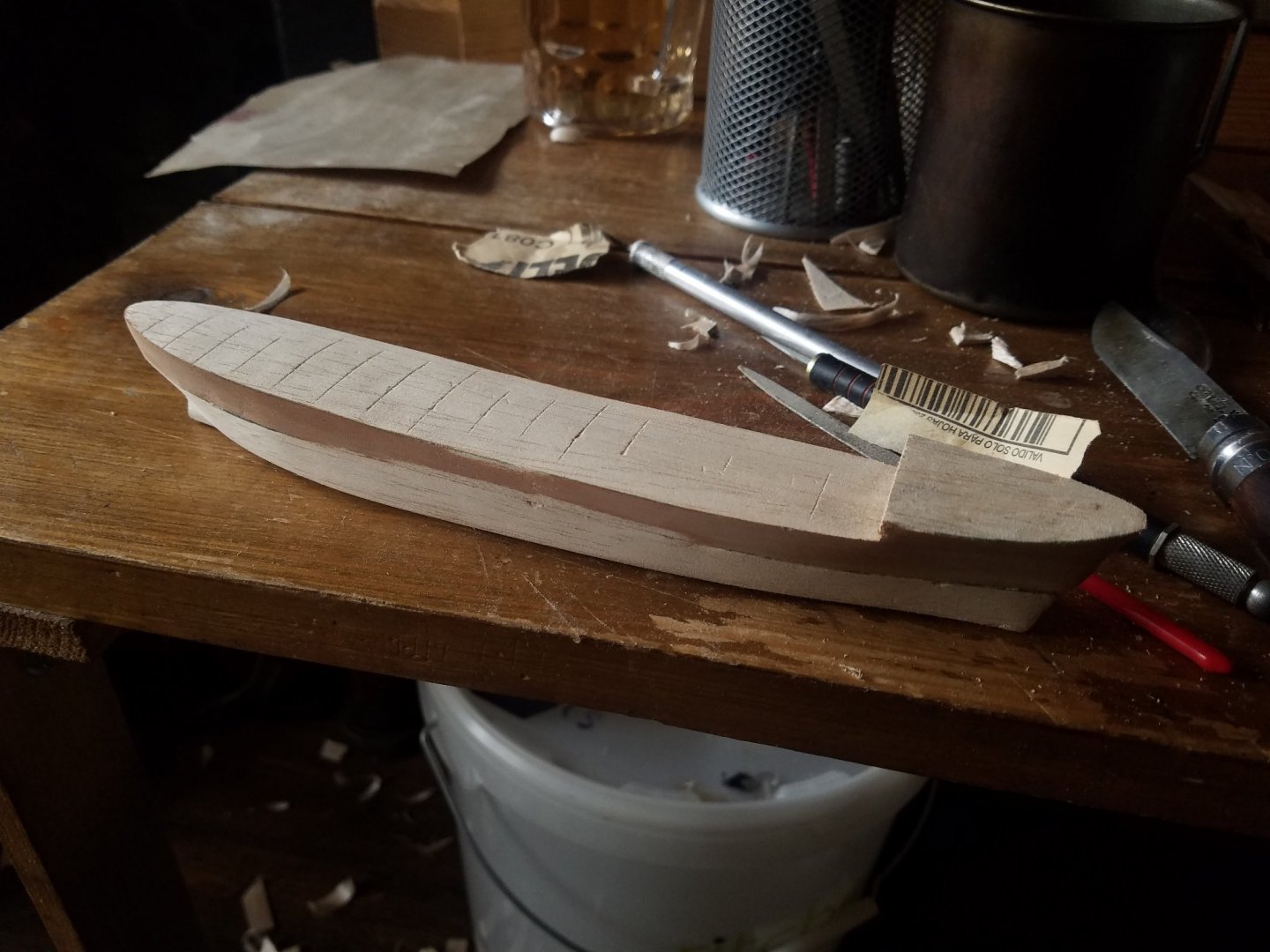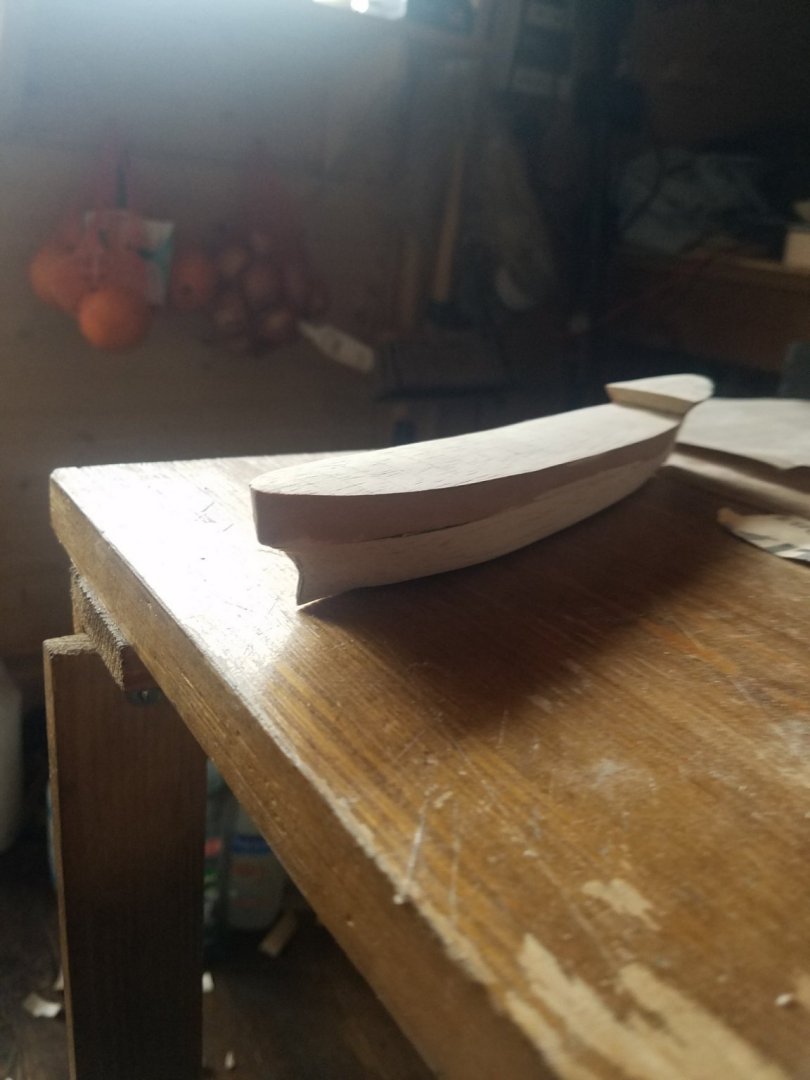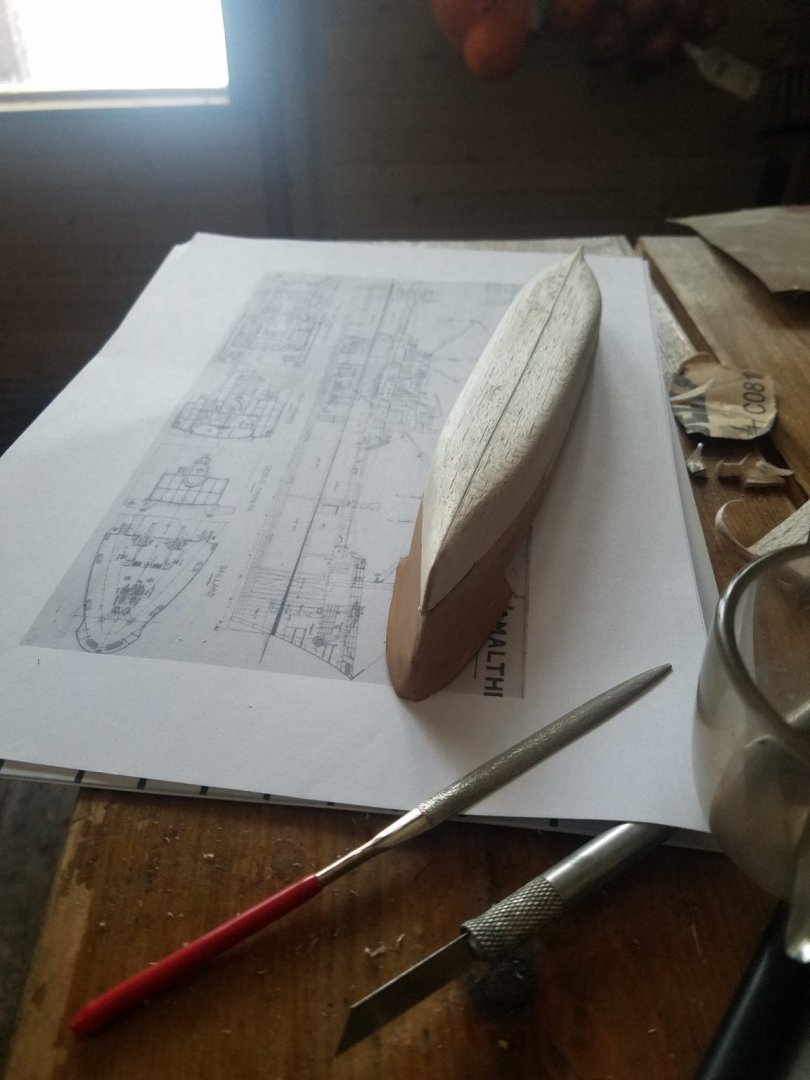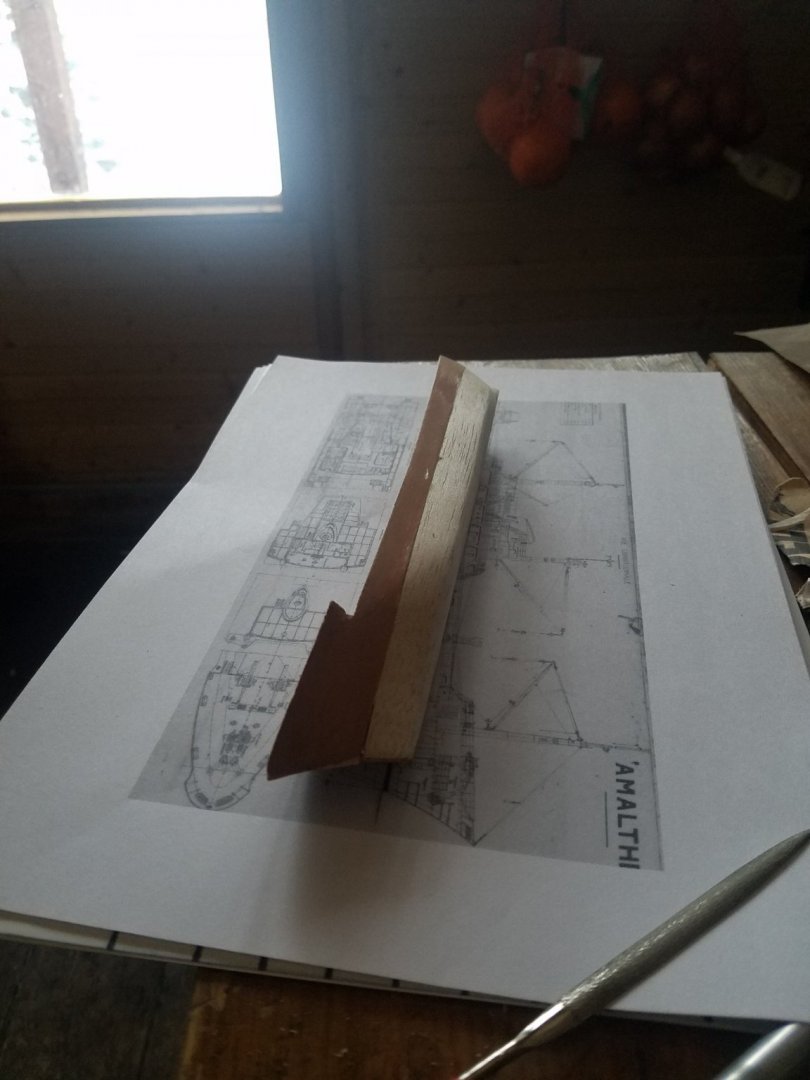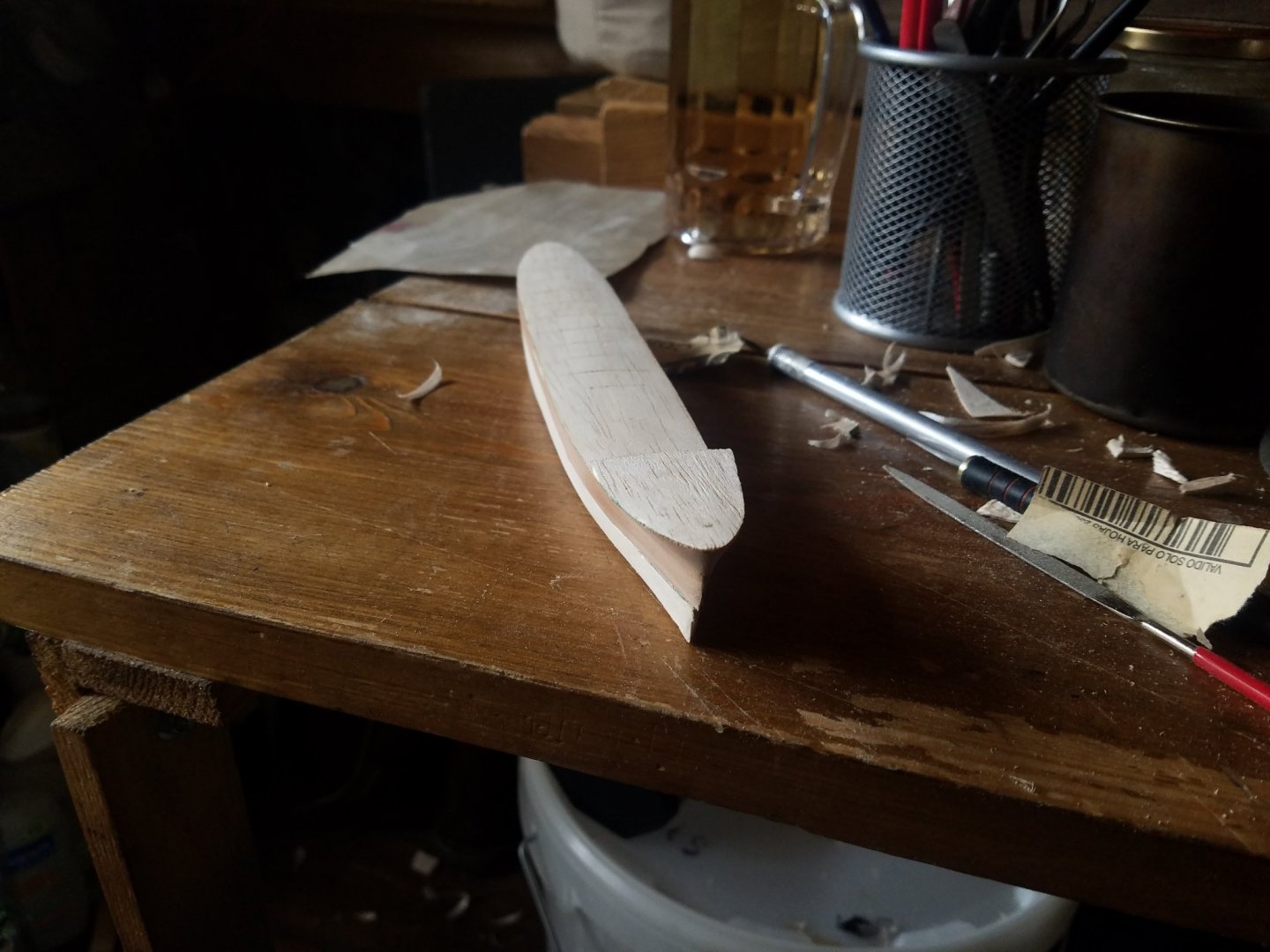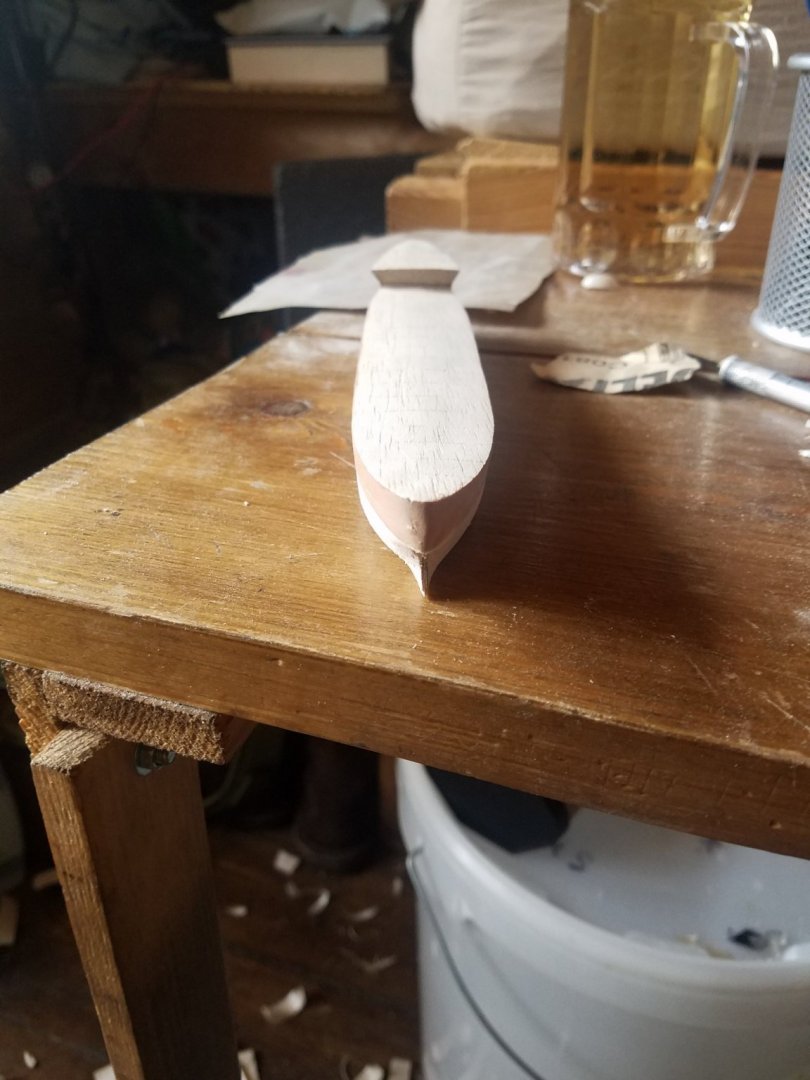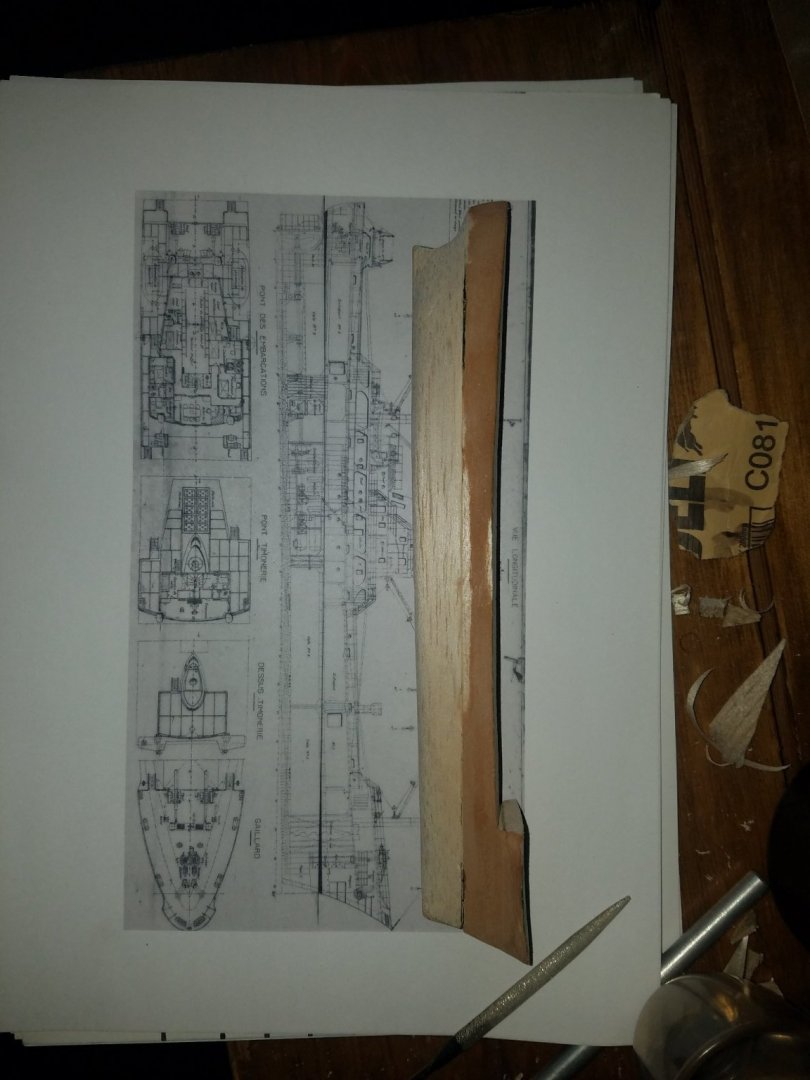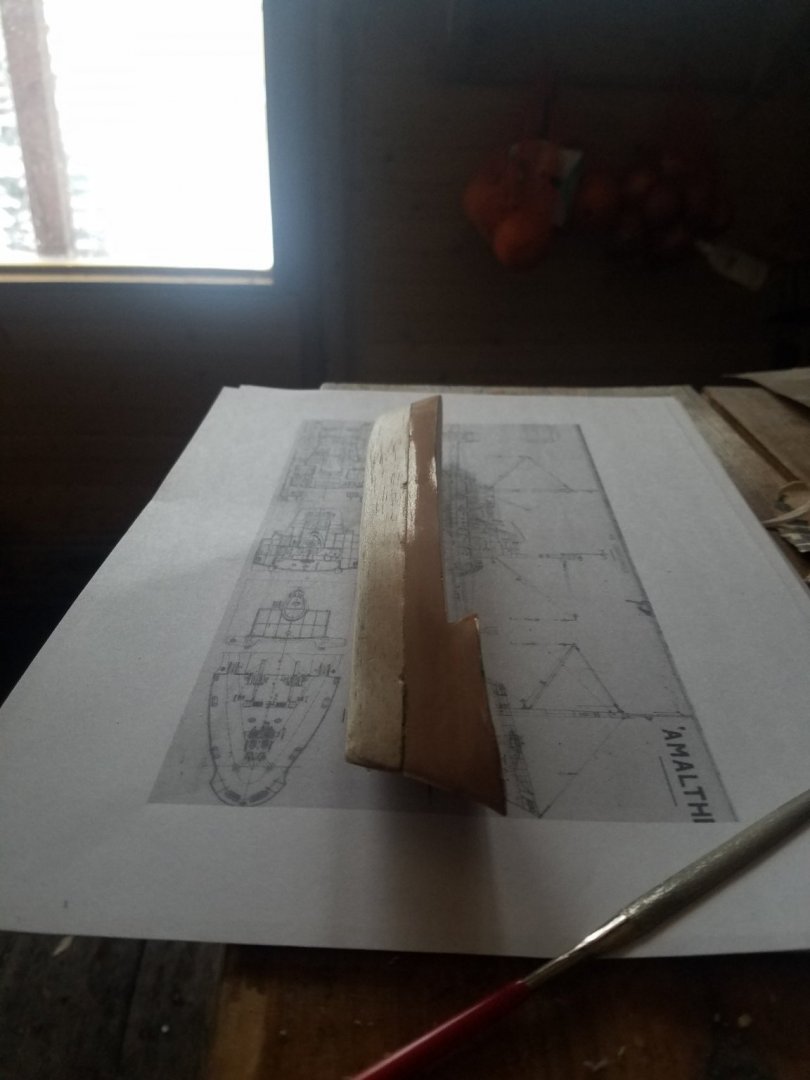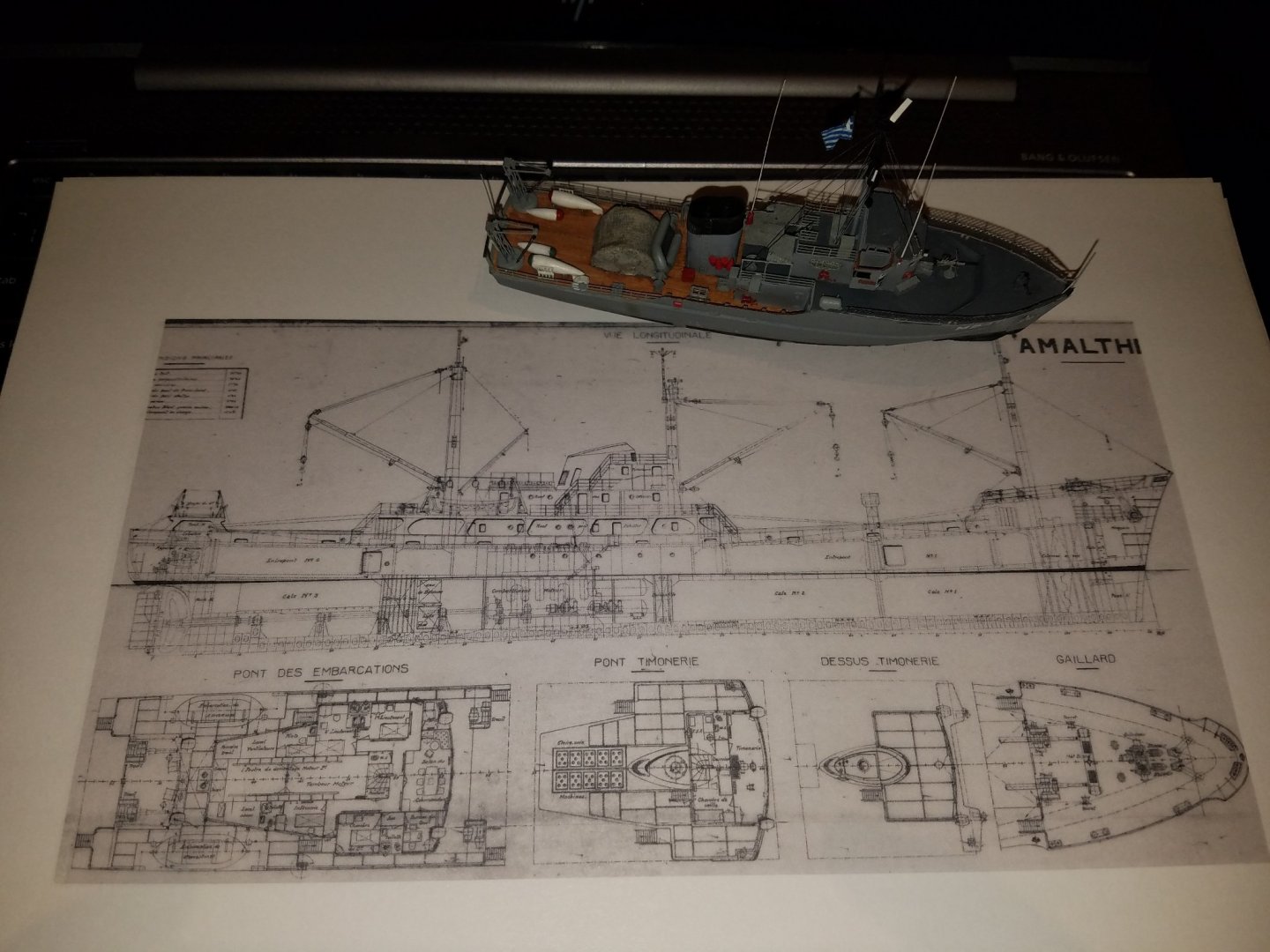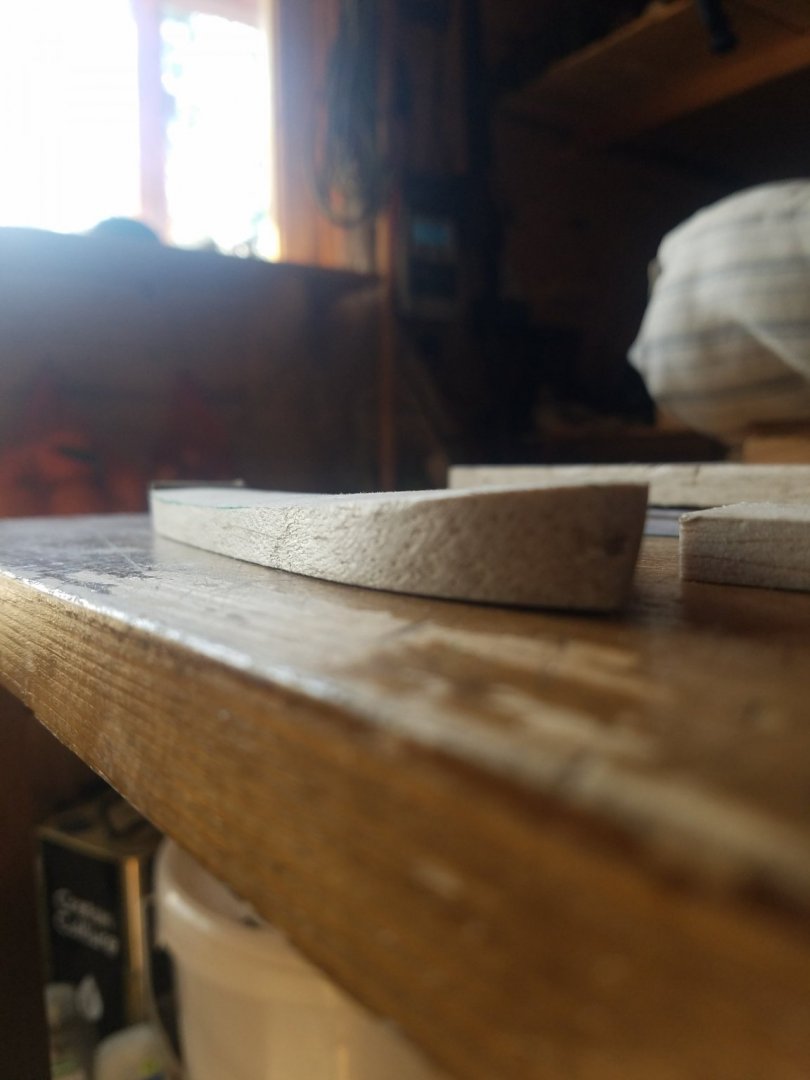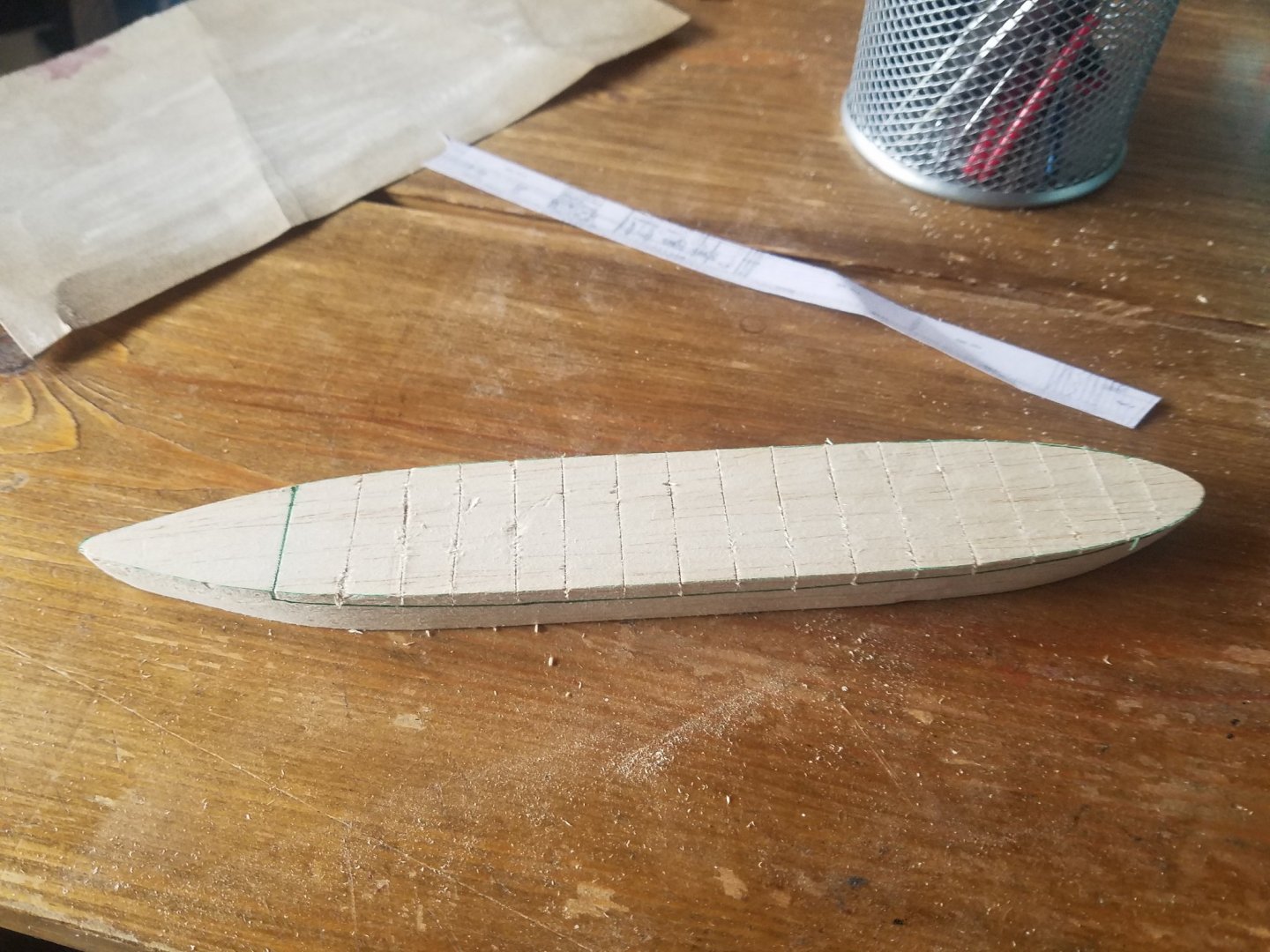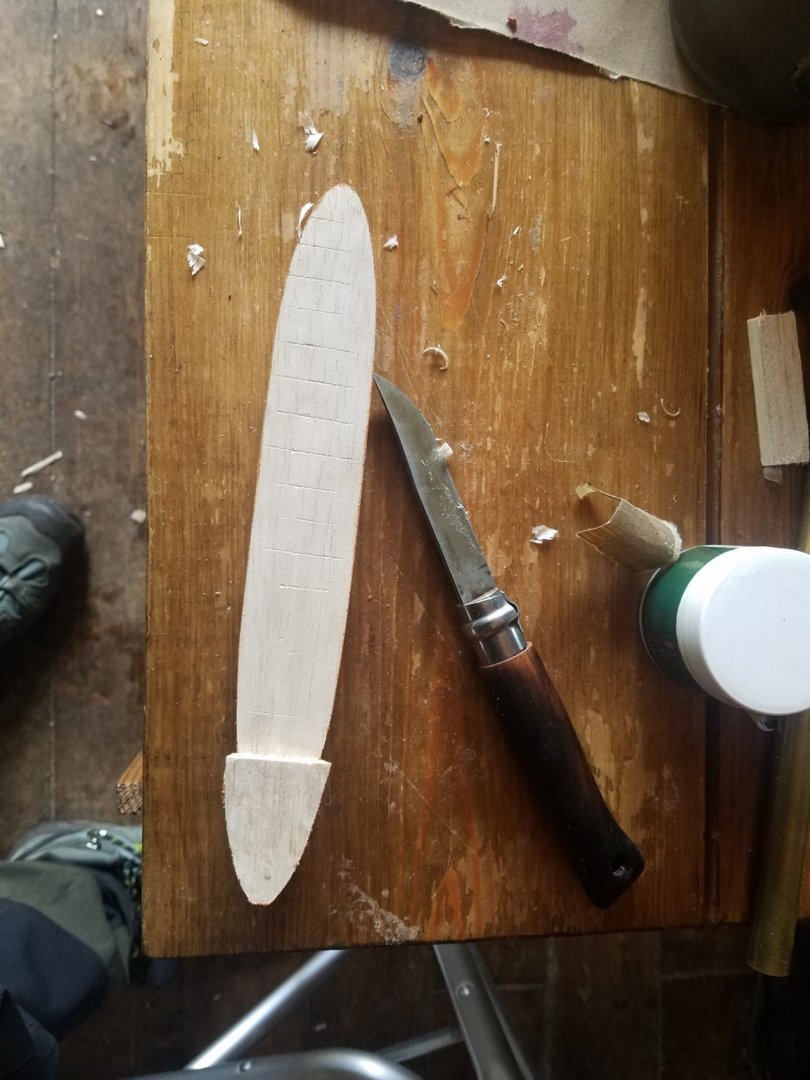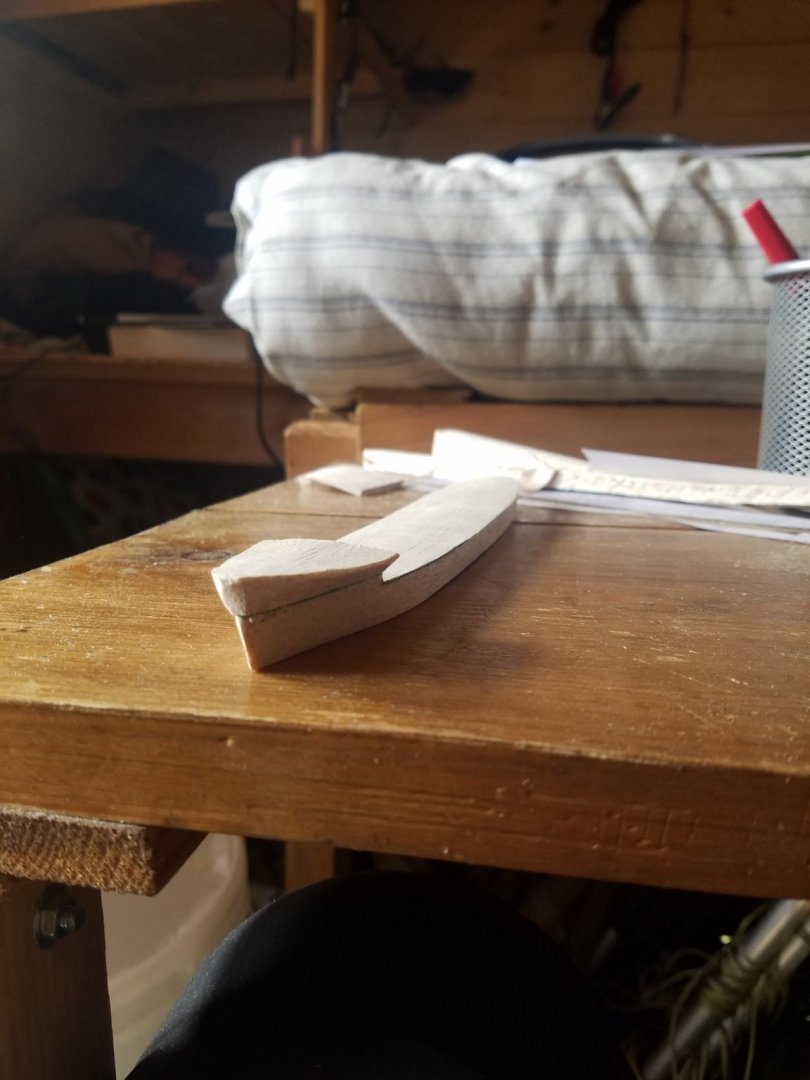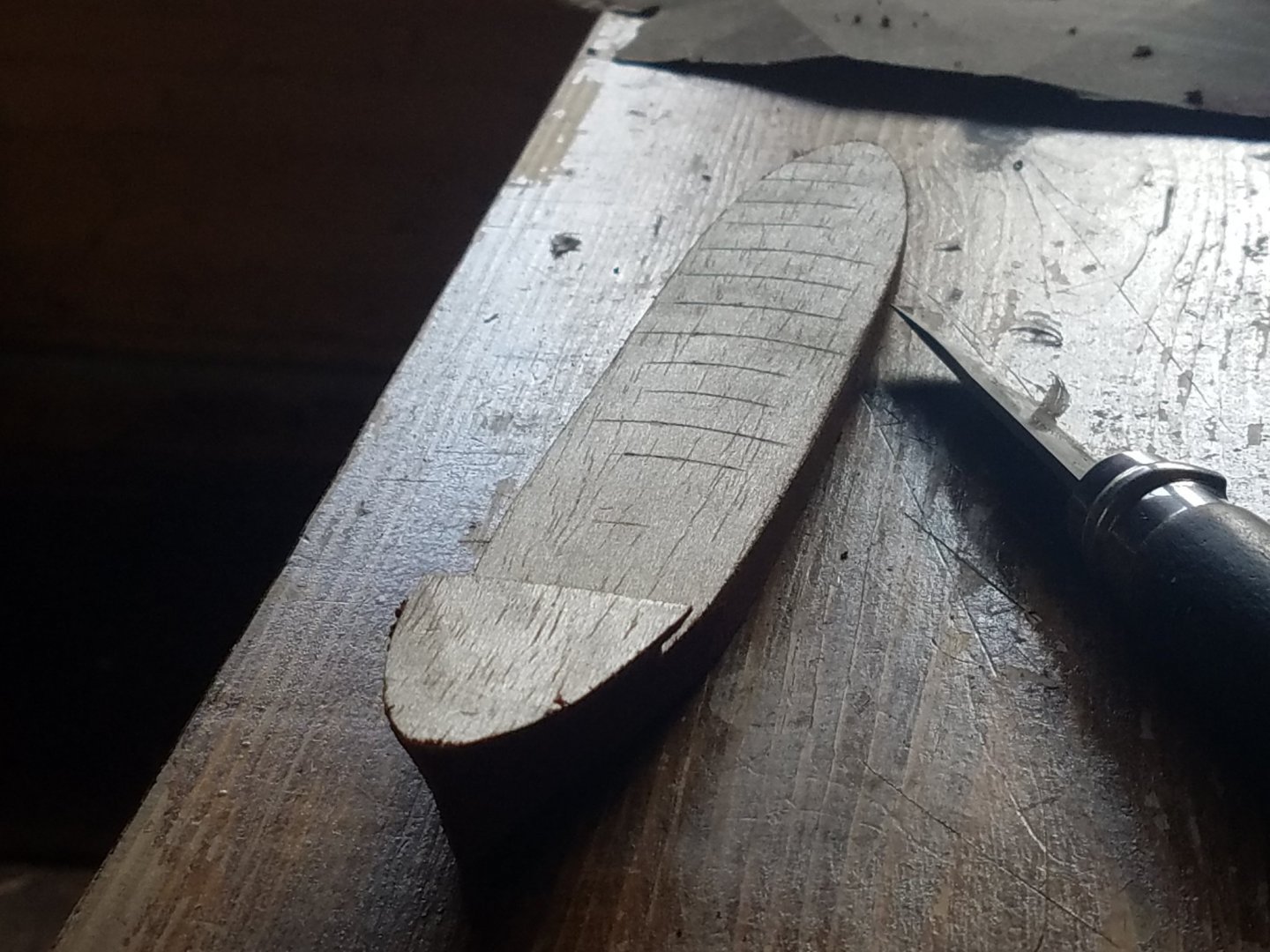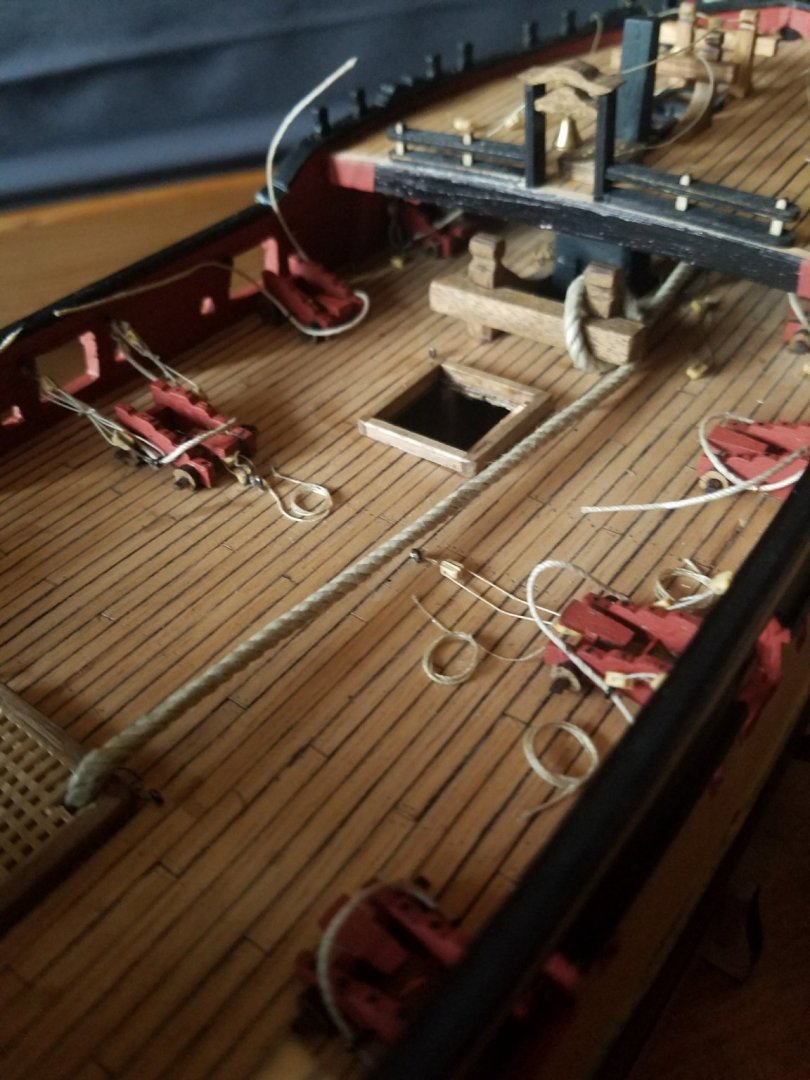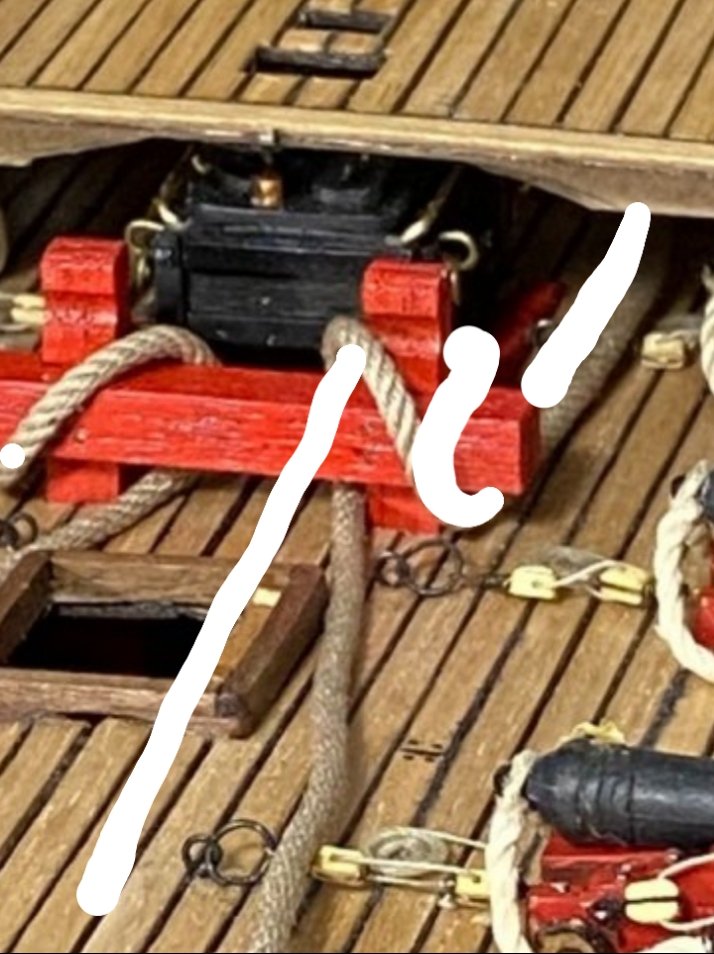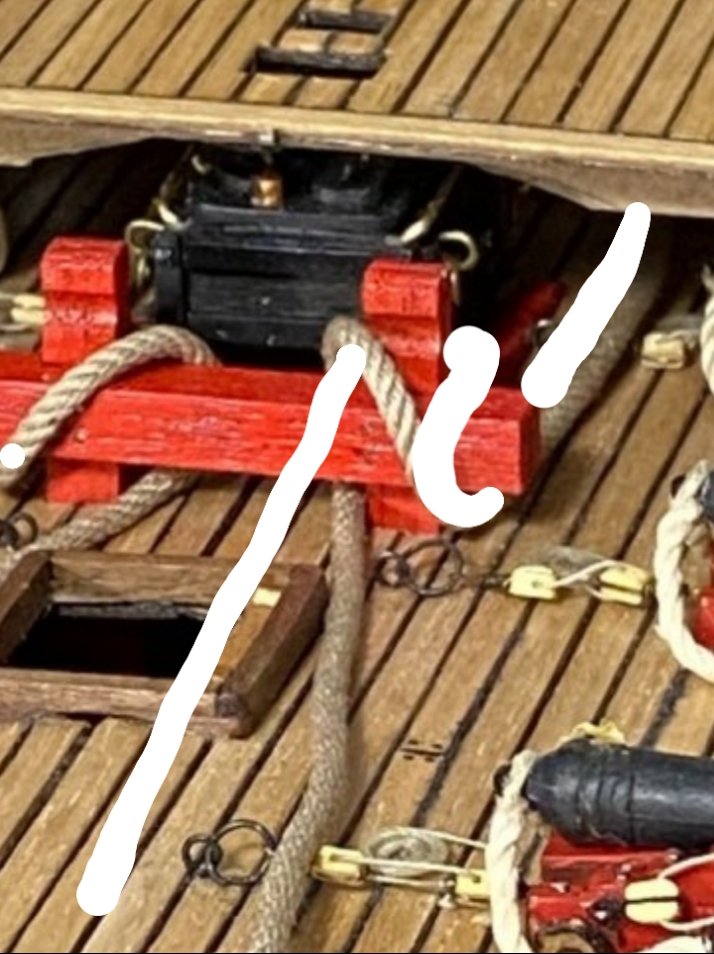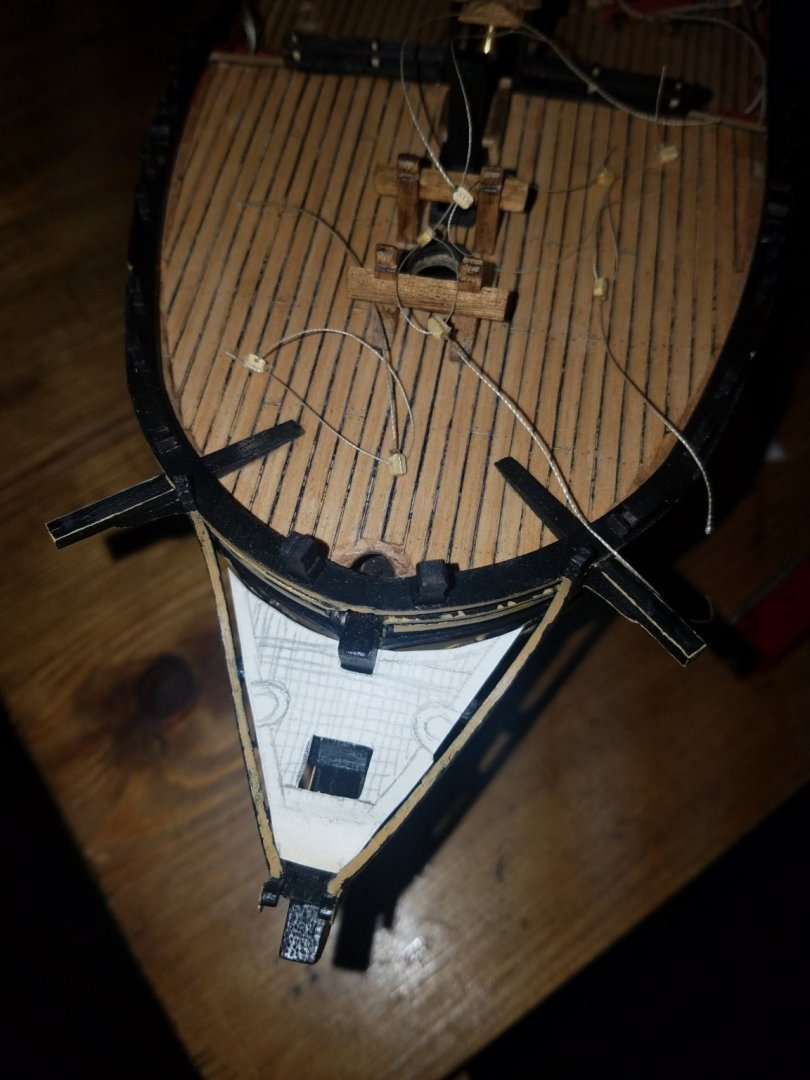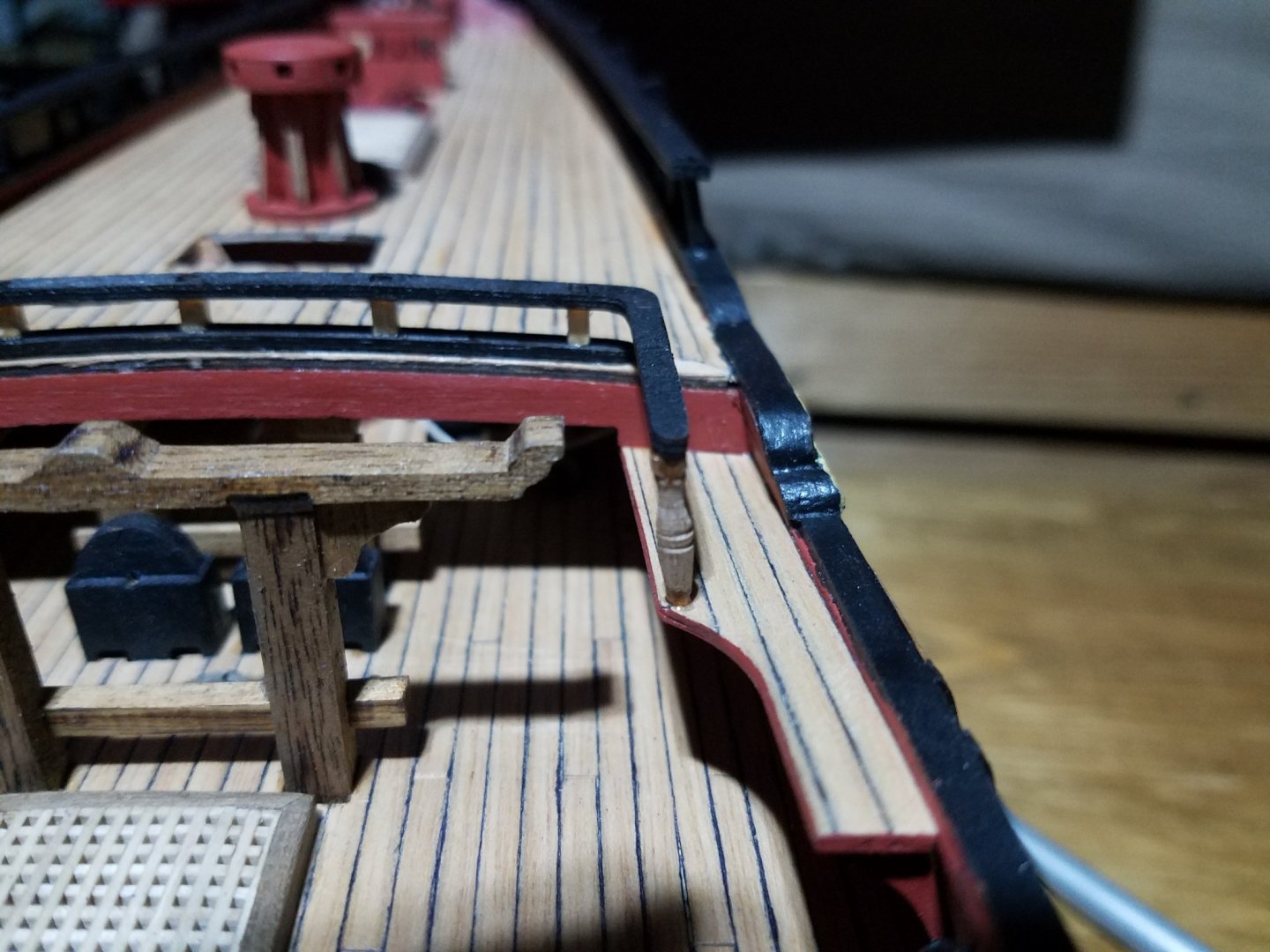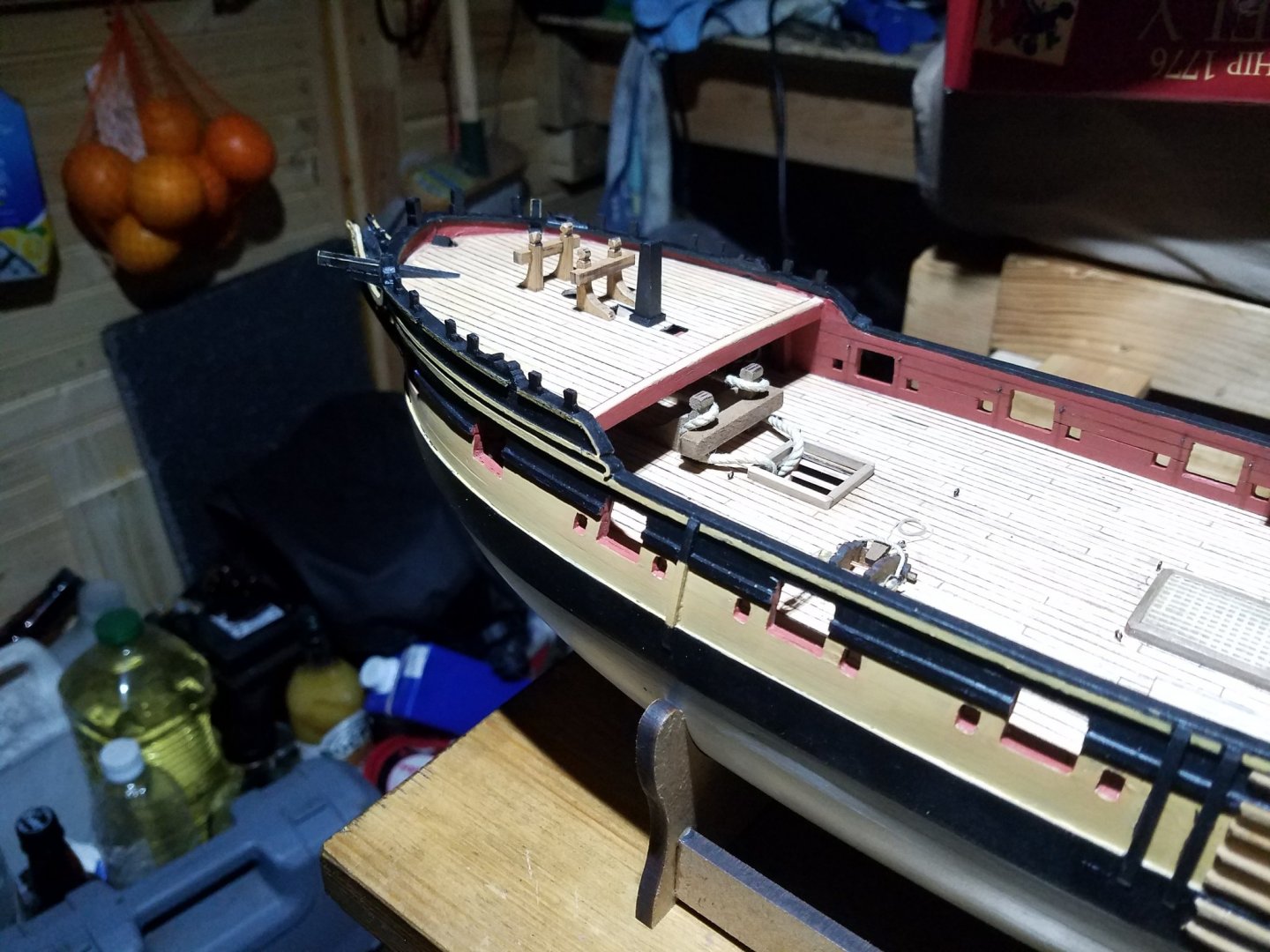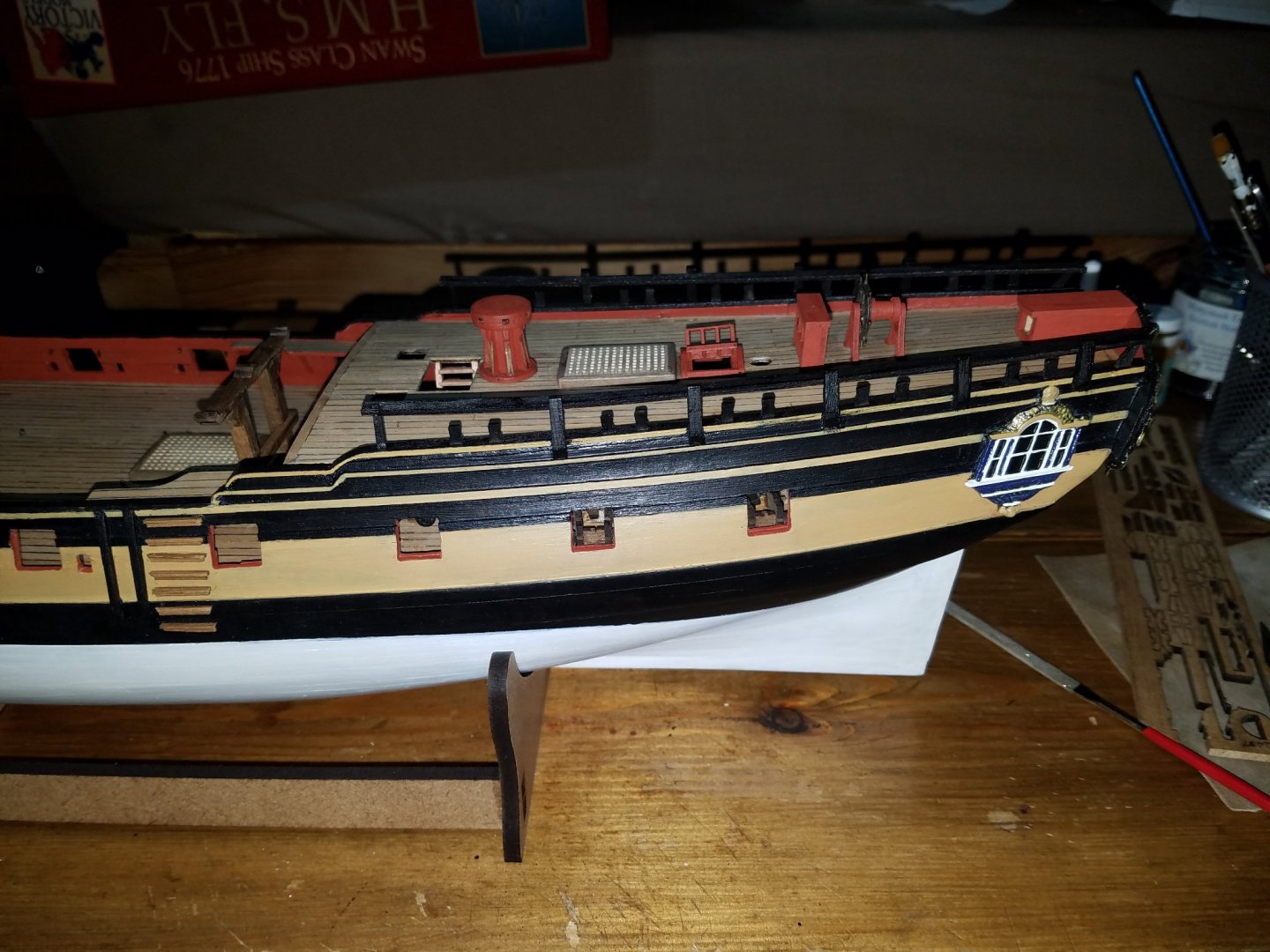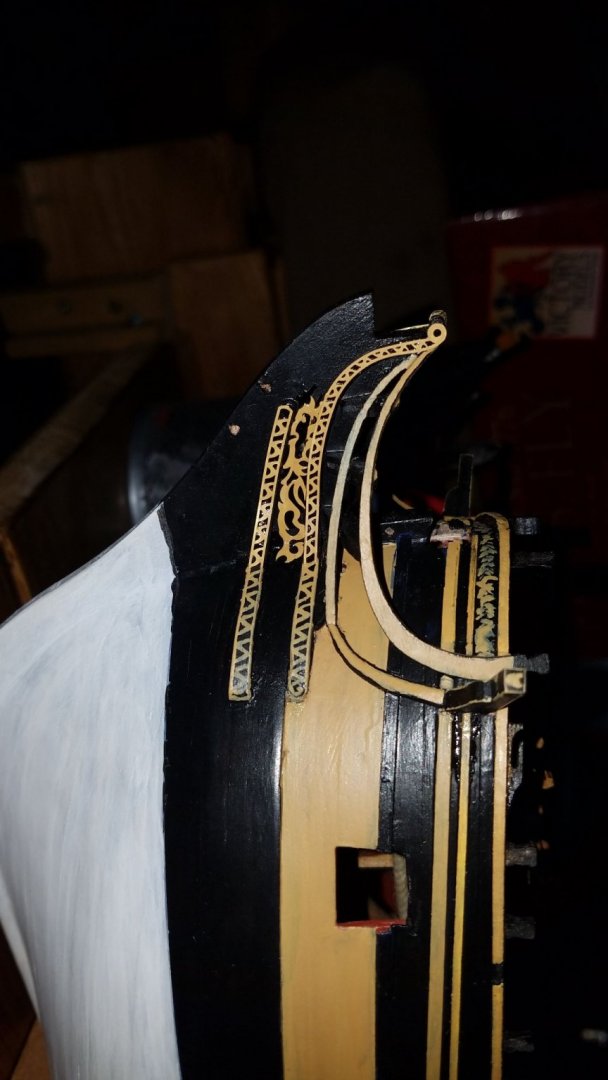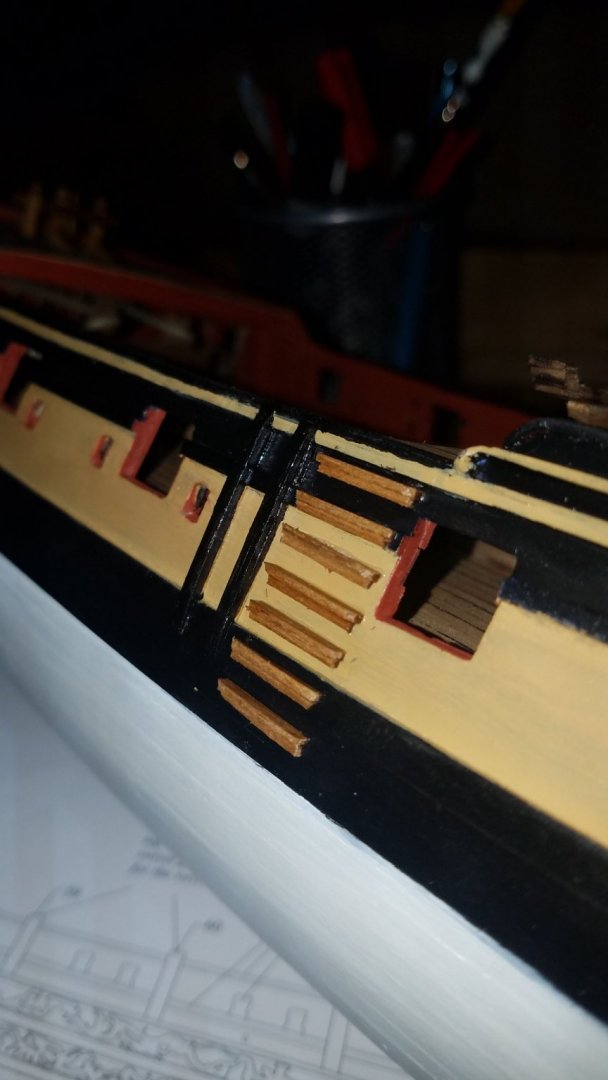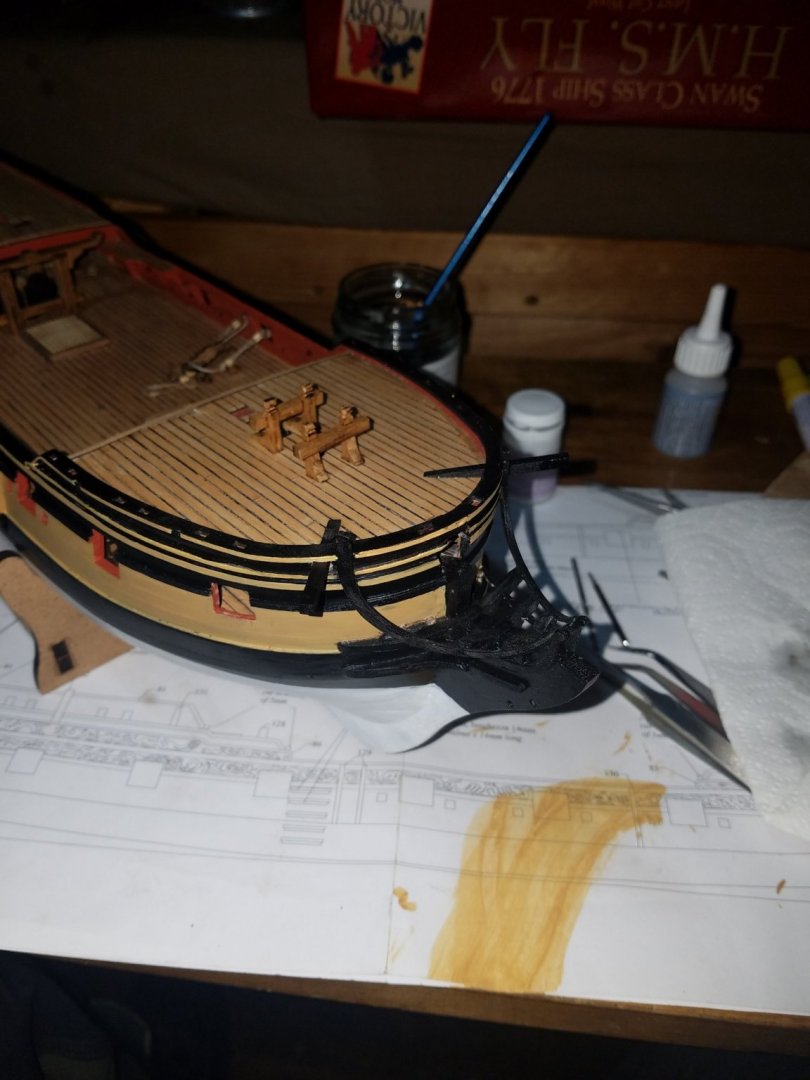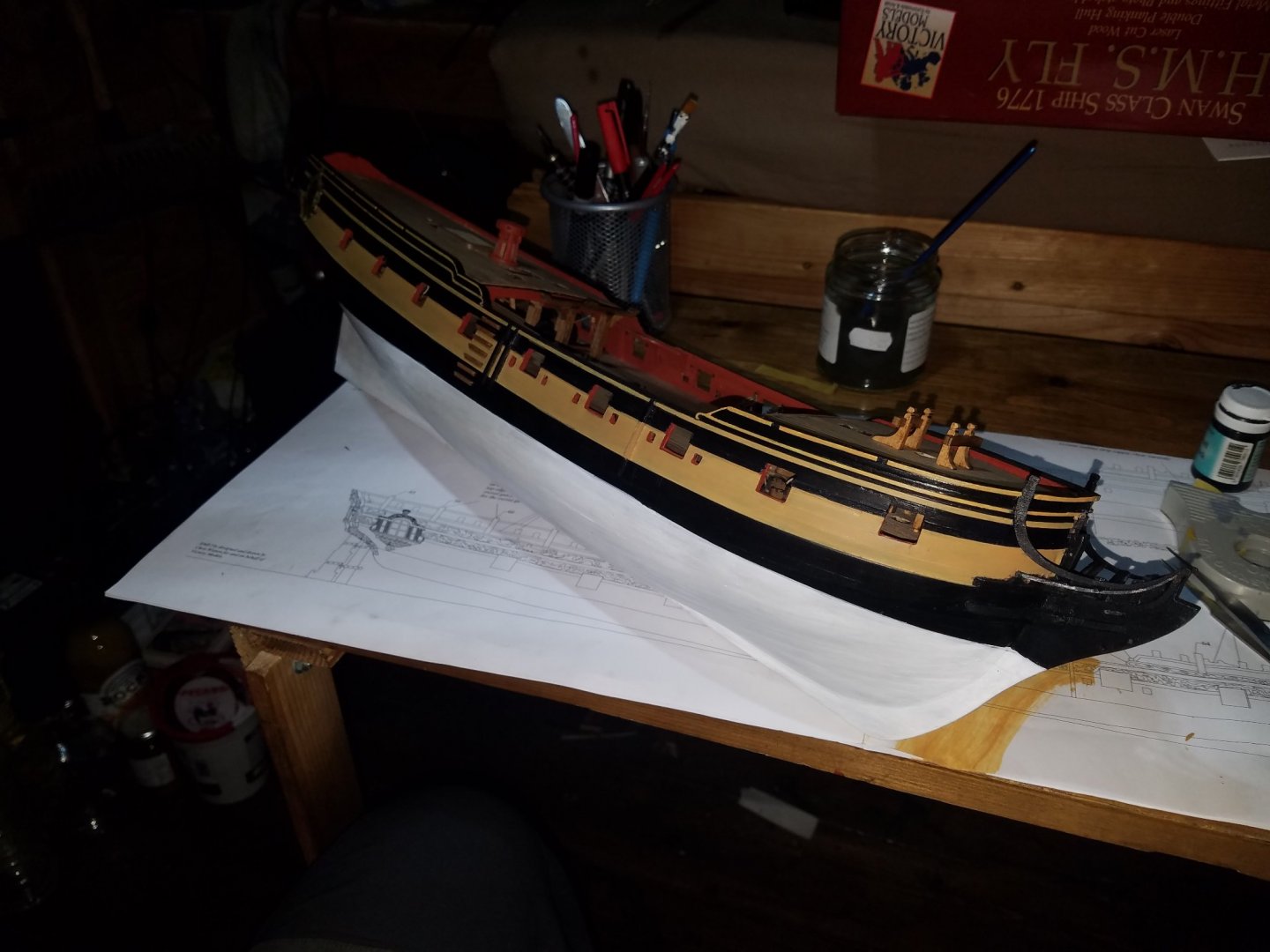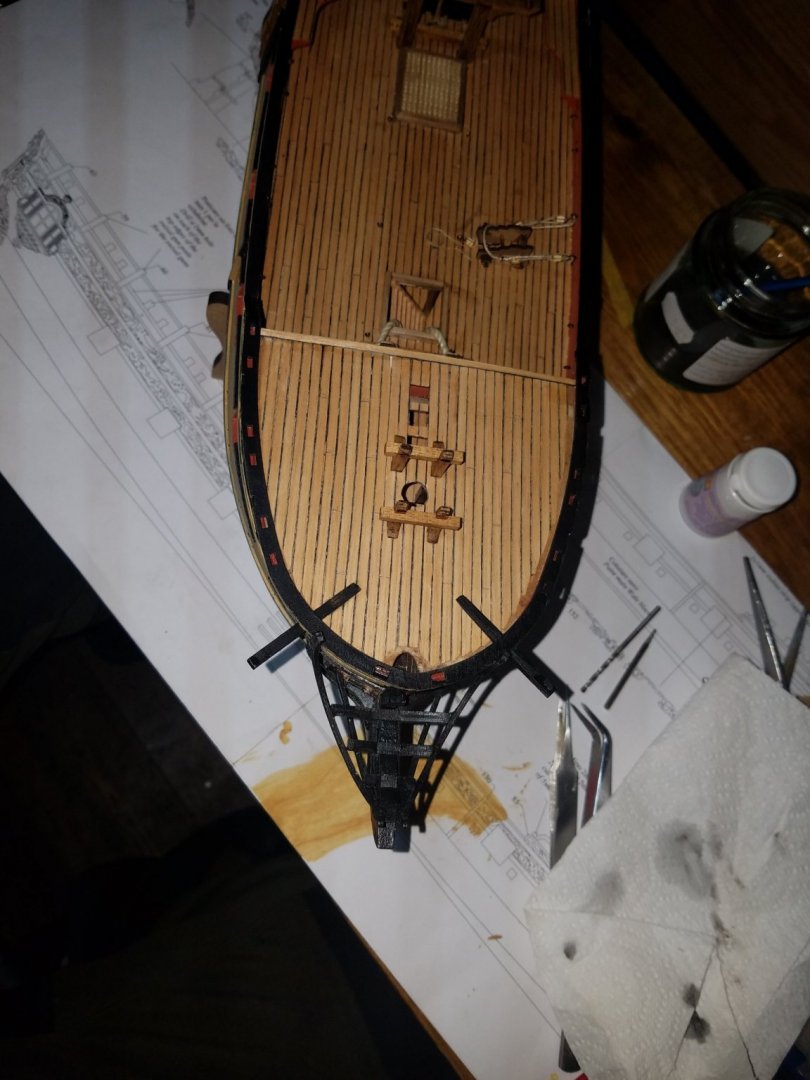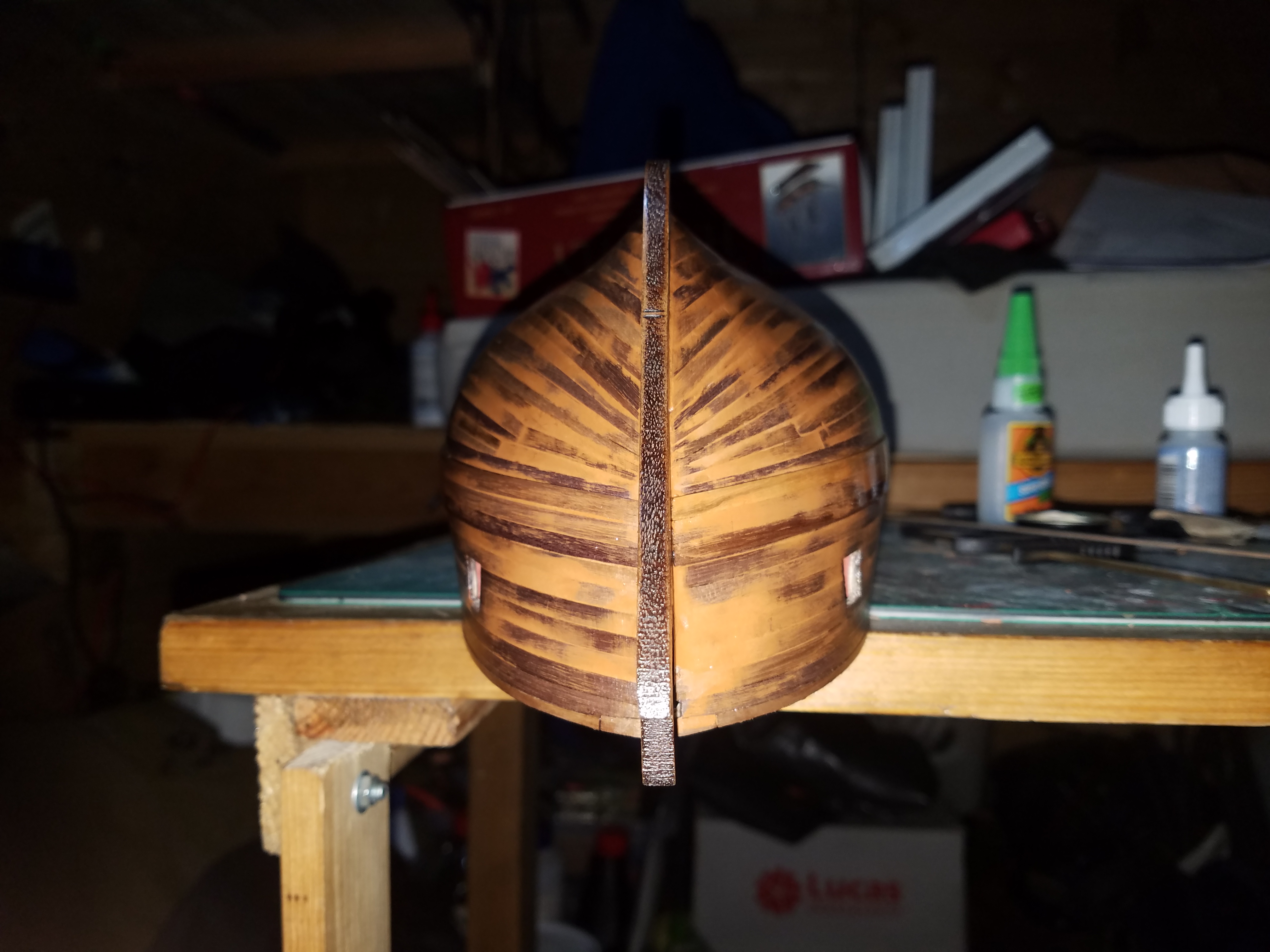
Sooty
Members-
Posts
76 -
Joined
-
Last visited
Content Type
Profiles
Forums
Gallery
Events
Everything posted by Sooty
-
Today I decided to try the hull below the waterline, and see how it turns out. It actually turned out great. I didn't bother with actual sections off the lines plan; instead, I just used a couple of profiles, sandpaper, files and my imagination (I am a Naval Architect by trade, so I can kind of visualise a hull off its lines plan). All balsa, but I split the lower half in two sides and I inserted a 'keel' cut off the profile, to help with the shaping. The model will be on a 'sea' diorama, so I won't bother much more with the bottom of the hull. Anyway! Enjoy the pics!
-
I always used a plane to taper the masts. I taper the dowels down to the required dimensions, first square, then octagons, then I sand them down to a circle. With a little practice, it is very hard to get this method wrong. You do need a well set-up plane with a very sharp blade though, and it can get messy if there are irregularities in the wood.
- 164 replies
-
- fly
- Victory Models
-
(and 4 more)
Tagged with:
-
Just started this one, after managing to get my hands on the original yard drawing with the help of an incredibly helpful Frenchman. This is a the build log of HS Evros (pennant number A415) of the Hellenoc (i.e. Greek) Navy. Hull and the major parts made of balsa, with some styrene sheets, copper tubing, stretched sprue, and leftover PE bits from previous builds of Liberty ships and destroyers. The ship started life in the mid 50s as 'Amalthée' (sister ships Enée and Borée), before being purchased by the West German Navy and used as an ammunition ship from the mid 60s till the mid 70s. She was then transfered to the Greeks, where she served till 2009. She spent the 2009-2020 period laid up in Souda Bay, with plenty of photos of her. My dad was her skipper for a couple of years in the mid 80s. Believe it or not, I went on a 3 day trip on her as an 8yo... different days, and I guess nobody would question the skipper 😂 I had a look to see if I could find any good photos of the boat. I was saddened to see that she was used as a missile & torpedo target in the summer of 2020. At least she now rests at sea, where she belongs. I decided to build the model with minimal references. While searching, I got in touch with a Frenchman who happened to know where I could find the original yard drawings. I will post the links later, as there are many mamy more drawings of other ships. Anyway, enjoy! The general arrangement plans, printed to 1:350, with a minesweeper for reference. LoA 80m.
-
It is likely to be July before my Fly can get outside to play again! I can of course keep building all the little pieces and finish the hull and the masts, then just wait till I am settled in before I install them and rig them up. Meantime, I will be watching your build!
- 59 replies
-
- Fly
- Victory Models
-
(and 1 more)
Tagged with:
-
I've been very quiet 😂 I have not lost my modelling mojo, nor have I pressed on with the build and not posted about it. Just a major geographical move now being firmly on the cards, so I think it is best to leave the masts off the boat till she is her new (forever) home! All going well, there will be a mantlepiece over a fireplace!
- 59 replies
-
- Fly
- Victory Models
-
(and 1 more)
Tagged with:
-
Your first planking is absolutely gorgeous. Keen to see how your build will progress!
- 104 replies
-
- pegasus
- victory models
-
(and 2 more)
Tagged with:
-
Ok, this is a pretty good video to watch, and it explains how they weighed anchor on HMS Victory. It talks about the messenger line and everything else involved! Apparently, it was a 5-6h job!
- 164 replies
-
- fly
- Victory Models
-
(and 4 more)
Tagged with:
-
The anchor cable had to be very thick to be able to take all the mooring forces, so you probably couldn't put too many turns over a capstan with it. Also, you probably wouldn't want to do that anyway, as it would mean running the cable all the way to the capstan, then to the hold. And -probably the main reason- you would never be able to handle the cable over the stoppers if it was under tension. Instead, they used to run a 'loop' of smaller diameter rope called a 'messenger', looped 3-4 turns over the capstan (for friction) and over to the bow (over a couple of rollers just in front of the manger boards). That piece of rope would run right next to the anchor cable, and it could be tied onto it along several spots to 'connect' the two ropes. You would turn the capstan, keep adding ties along the two ropes as they met, and remove them as the anchor cable was approaching the hole down to the holds. That way, the anchor cable was under no tension once past those ties, so you could handle it easily, turn it over the stoppers etc. I'll try and find a sketch for you, as it would probably explain it much better!
- 164 replies
-
- fly
- Victory Models
-
(and 4 more)
Tagged with:
-
I just drilled and filed off 1 square off the mid-ship hatch's grating, at the two fore corners. I will fill and stain the adjacent parts of the gratinf, to make it look like it's not part of the grating but a fixed part of the hatch coaming, and have the rope pass through the hole. It LOOKS like this is the way to go, but still not 100% sure. It appears that this is what it would be for weighing anyway, but I want to show it like it is about to be lowered, which could be different. I realised I should have installed the messenger rope a long time ago. This could be interesting 😂
- 164 replies
-
- fly
- Victory Models
-
(and 4 more)
Tagged with:
-
Crikey, that really is SOME build! Thanks for the tip!
- 59 replies
-
- Fly
- Victory Models
-
(and 1 more)
Tagged with:
-
It all makes sense, as those were boats which primarily sailed downwind or on a reach at best, e.g. the wind would always be away from the bow, unless riding on the anchor. Speaking of anchors, any idea how the anchor cable would normally be riding over/around the stopper bits, when the anchor was secured for sailing? I am planning to set up the ship to look like she has just arrived somewhere; one anchor stowed, one anchor hanging from the cathead ready for lowering, the ship's boat being lowered and all but a couple of sails furled. I am confused as to how the cable would run for the stowed anchor and this is what I had in mind;
- 59 replies
-
- Fly
- Victory Models
-
(and 1 more)
Tagged with:
-
Hello Tim, great job, the bow platform is looking good! I am still figuring out how to do mine. On the anchor cables; I think we need to ask for help. I took mine out as I wasn't sure about how I had them going over the stoppers. I am not 100% sure, but you may also have them in a wrong way; the cable should be able to run along the deck, I think on the outside of the stoppers. When placed over the stoppers, I think it should look like this; My reasoning is that -by being on the outside of the bits- it would allow it as straight and long a run towards the capstan as possible, for the messenger rope to hold it. Again, I am not 100% on this one, and I am stuck with the same issue 😂 Anyone knows for sure?
- 164 replies
-
- fly
- Victory Models
-
(and 4 more)
Tagged with:
-
That is all related to my problem 😂 I am a Naval Architect by trade, a keen sailor, worked onboard ships for a bit in my earlier years and now work with the oil&gas industry (a pretty risk-conscious sector), so it is hard to lose all the preconceptions I come with regarding risk assessments, the 'How I would do it' and all the expectations I would have from a modern ship 😂 I kind of need to unlearn everything and resist the temptation to do it my way 🤣
- 59 replies
-
- Fly
- Victory Models
-
(and 1 more)
Tagged with:
-
That's brilliant Tim, thanks for the photos, good to see it without any clutter around it! I will probably do something similar then. Still not 100% convinced the heads would be there, as I still think it is too low down to be safe for all the crew visiting a couple of times a day in anything but relatively calm weather. Then again, those were different times and men were being sent 100ft up rope ladders and yards of a rolling and pitching ship with no fall protection 😂
- 59 replies
-
- Fly
- Victory Models
-
(and 1 more)
Tagged with:
-
Grating it is then! I take it there would also be some sort of railings, some way of getting down there from the bow's bulwark, and of course the heads! It would be a tight squeeze for the heads' 'products'to clear anchor cables and the cheeks, so I wonder where they were placed. Probably just inboard of the grating's outer edge. Just as well I will be doing this, as I was itching to do something other than the guns... I left the exposed ones (and -crucially- their rigging) till now, so it is an absolute headache to do them; 4h for 2 of them, and I think I did a sloppy job 😱 PS, I made a quick template. Does this make sense? Relatively flat, hole for the hold-down rigging for the bowsprit, one head either side along the outboard edge (to clear the boat on the way down). My main question here is how would men get up from /down to there? Also, this being such a small boat, most of the time the bows would be pretty wet. On bigger ships, the 'heads' would be much higher, so I wonder if the heads on these were somewhere else?
- 59 replies
-
- Fly
- Victory Models
-
(and 1 more)
Tagged with:
-
You mean grating over a curve? 😨 That would be a tough one and Interesting to see, keen to see pics on your blog! I opted on not grating the bow on the basis that it would be a small area with not much access or much to do there, so I assumed there would not be a platform. I did have a good go at painting decorations. For the next build, I think I will find pens of the right colour and try working with them. I think there are very fine tip pens with gold ink.
- 59 replies
-
- Fly
- Victory Models
-
(and 1 more)
Tagged with:
-
OK, I sorted out my camera and this time got some proper photographs, after some further work and some corrections: 1) I removed the anchor cables, as they were installed over the stopper bits the wrong way. Now I have no rope to work with, so they'll have to wait till I can get some suitable 'rope'. 2) Most of the deck railings are now done. 3) I managed to paint what was visible of the 'covered' gun carriages red, and of course painted red the ones that were not yet installed. 4) I made a 'stove', so now there is at least something black and bulky where one would expect to see a stove! 5) Some more paint touch-ups. It kind of shows that the paint has been touched up several times, but I like that as it is probably exactly how the real thing would have looked after a few months at sea. 6) The bellfry is on, though I should probably weather the bell a little as it looks too bright. 7) I made some very very faint marks for where the countersunk nails (or screws?) would have been on the deck planking. There is a fair bit of dust on the model, but it should go away with the 'airbrush treatment' and maybe a little brush work. When all is done, I will likely spray a coat of matte acrylic varnish, before I start with any of the masts and rigging, and start to keep the model covered when not working on her.
- 59 replies
-
- Fly
- Victory Models
-
(and 1 more)
Tagged with:
-
You are correct, I like to work with the vessel on my lap, so I avoided installing too much sticking out of the sides and bottom of the hull for now. Besides, a competent Master should be able to steer her just by using the foresails and mizzen 😉
- 59 replies
-
- Fly
- Victory Models
-
(and 1 more)
Tagged with:
-
A bit more progress today. I will need to start thinking about installing the gun carriages and tackle, or it will start getting a bit hard to do that soon! On that note, I just realised the carriages should have been painted red 😂 I think I can sort that out with a fine paintbrush. I found the wooden pillars for the railings to be a bit out of scale, so I turned some new ones using a file and dowel on my Dremel. A few bits of grating, hatch coamings to add, as well as various bits and bobs around the deck. Then, the channels and on to masts and rigging!
- 59 replies
-
- Fly
- Victory Models
-
(and 1 more)
Tagged with:
-
I had a go at painting the decor around the bow, on the cheeks. Have a look below, half is with PE, the other half is painted. I might strip the PE altogether and paint it all, as I think it looks pretty decent! Ignore the bit under the top railings, I will sort that out.
- 59 replies
-
- Fly
- Victory Models
-
(and 1 more)
Tagged with:
-
Boarding steps, fenders and cat heads installed, as well as doing some paint tidying up and highlighting the strakes with ochre. Still a lot of paintwork to sort out, but I like this look much more than she was previously with the decorations.
- 59 replies
-
- Fly
- Victory Models
-
(and 1 more)
Tagged with:
About us
Modelshipworld - Advancing Ship Modeling through Research
SSL Secured
Your security is important for us so this Website is SSL-Secured
NRG Mailing Address
Nautical Research Guild
237 South Lincoln Street
Westmont IL, 60559-1917
Model Ship World ® and the MSW logo are Registered Trademarks, and belong to the Nautical Research Guild (United States Patent and Trademark Office: No. 6,929,264 & No. 6,929,274, registered Dec. 20, 2022)
Helpful Links
About the NRG
If you enjoy building ship models that are historically accurate as well as beautiful, then The Nautical Research Guild (NRG) is just right for you.
The Guild is a non-profit educational organization whose mission is to “Advance Ship Modeling Through Research”. We provide support to our members in their efforts to raise the quality of their model ships.
The Nautical Research Guild has published our world-renowned quarterly magazine, The Nautical Research Journal, since 1955. The pages of the Journal are full of articles by accomplished ship modelers who show you how they create those exquisite details on their models, and by maritime historians who show you the correct details to build. The Journal is available in both print and digital editions. Go to the NRG web site (www.thenrg.org) to download a complimentary digital copy of the Journal. The NRG also publishes plan sets, books and compilations of back issues of the Journal and the former Ships in Scale and Model Ship Builder magazines.


